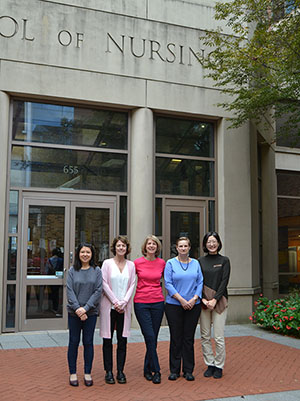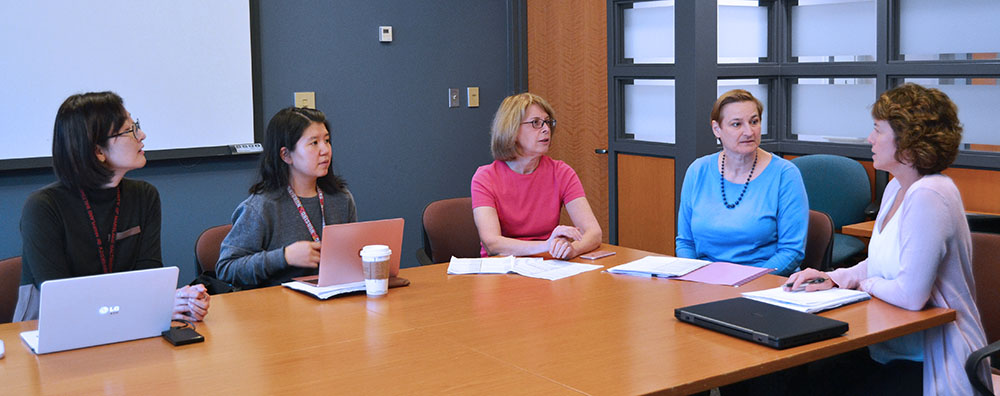
Meet the Research Team!
See 'Research Team' below to learn more about us.

Meet the Research Team!
See 'Research Team' below to learn more about us.
The research has been funded by the National Institute for Occupational Safety and Health, Agency for Healthcare Research and Quality, the National Institute on Drug Abuse, and the National Council State of Boards of Nursing.
The Impact of Employee Assistance Programs (EAP) on Substance Use in Nurses is our latest study expanding upon nurse worklife factors. It will shed light on the little known impact of EAPs in helping nurses who use substances get the care they need, and stay meaningfully employed. This time, investigators will connect directly with nurses who are in recovery from substance use, EAP professionals and other stakeholders, to learn about best practices to support and promote optimal recovery and safe re-entry to the nursing workforce.
Most state boards of nursing (BONs) offer evidence-based programs for nurses with substance use (SU) problems or substance use disorders (SUDs), often referred to as alternative-to-discipline programs, which are designed to protect the public while fostering nurse recovery and well-being. In addition, many workplaces offer EAPs that can help address these and other employee concerns.
By surveying EAP professionals, we will identify:
Findings will allow us to identify gaps and shed needed light on the impact of EAP systems to make recommendations for policy and practice.
This study will also explore how recovering nurses use EAP services for SU/SUDs, including what services are offered or needed to assist with treatment and recovery/re-entry to practice.
We will do this by conducting a qualitative analysis based on interviews with EAP providers and other stakeholders (e.g., Alternative to Discipline programs, Boards of Nursing) in four US states, emphasizing best practices, focused on communication and collaboration within those states. Perspectives from recovering nurses will provide insights as to how the EAP system functioned for their situation. Finally, recommendations will be made to improve the chance of nurses receiving needed screening, referral, treatment, and follow-up care.
Nurse Worklife and Wellness
(2019 to 2021)
The Nurse Worklife and Wellness study is another venture in a line of research that has concentrated on studying work-related factors as they relate to nurses’ health.
In this recent study, 1,200 actively licensed RNs in 9 US states participated in a survey that assessed job demands (physical, psychological); difficult work schedules; availability of workplace wellness offerings (e.g., naps, exercise); substance use and other lifestyle factors. This study is providing data on the prevalence of occupational health and wellness issues among nurses that can be used for planning purposes, including to design interventions to support nurses and improve nursing working conditions. In addition, policy implications of the study findings include promotion of structural changes that facilities employing nurses can make to decrease job demands and promote nurses’ health and wellness. Additional papers are in preparation and forthcoming.
Each of the studies listed below used a different population-based sample of RNs, and data were collected using mailed surveys with good response rates.
Nurses' Worklife and Health Study III
(Part III; 2001 to 2006)
This longitudinal study of RNs was designed to obtain detailed information on work schedules, including long work hours, on-call and mandatory overtime requirements, working on scheduled days off, and shift rotation. The relationship of these scheduling factors to two important outcomes, musculoskeletal disorders (neck, shoulder and back) and needlestick injuries, was also examined. Mailed surveys were used to examine variables at baseline and at six and 15 months. This allowed the researchers to make inferences about the effect of these work patterns on the incidence of musculoskeletal disorders and needlestick injuries.
Nurses' Worklife and Health Study II
(Part II; 1998 to 2001)
This cross-sectional study of 1,428 RNs from diverse settings looked at patterns of neck, shoulder, and back injuries and disorders in relation to physical demands, work schedule, and health care changes that influence nursing work (for example, increased job responsibility, floating off unit, unfilled positions, layoffs, high patient loads and acuity, shorter lengths of stay, and use of unlicensed personnel).
Nurses' Worklife and Health Study I
(Part I; 1993 to 1998)
Twenty-five years ago, our team conducted the first nationwide survey of substance use and related problems among US RNs. This cross-sectional study examined various aspects of nursing, such as specialty, work schedule, and job strain, on patterns of substance use among more than 4,400 RNs.
The Nurses' Worklife and Health Studies and Nurse Worklife and Wellness Study have made a contribution to scientific knowledge in the following areas
Substance Use
New:
Previous:
Fatigue/Sleep
New:
Previous:
Personal Safety for Nurses
New:
Previous:
Musculoskeletal Injury/Disorders (neck, shoulder, back)
Needle-stick Injuries
Work Schedules

Alison M. Trinkoff, ScD, RN, FAAN, Professor, Principal Investigator (PI) has been at the University of Maryland, School of Nursing (UMSON) since 1991, where she has been studying the influence of nursing work environments, nurse injury, SU and related outcomes. Her first R01 as PI was funded by the National Institute on Drug Abuse (NIDA) for a nationwide survey of SU/SUDs in RNs, and she has been PI on 4 additional R01s and 6 NCSBN-funded regulatory research grants. Her experience includes mixed methods, analysis, and designing and implementing surveys. In addition, she teaches research design and analysis and mentors PhD students.
Victoria Selby, PhD, PMH-CRNP, PMHNP-BC, CARN-AP, Assistant Professor, Co-Investigator (Co-I), at UMSON, has been working as a psychiatric nurse practitioner since 2012, specializing in co-occurring substance use (SU) and psychiatric disorders. Clients come from diverse backgrounds and include healthcare professionals. Prior to this, she had experience as an RN in emergency and acute psychiatric settings. Dr. Selby also designed and implemented a post-baccalaureate certificate in substance use and addictions nursing (SUAN), and an undergraduate focus area in addictions at UMSON. She was the PI on two grants supporting this work from the Maryland Higher Education Commission and Directs the SUAN program. Dr. Selby adds first-hand clinical expertise, and has been instrumental in working to identify relevant RN SU/SUD research priorities.
Jodi Frey, PhD, LCSW-C, CEAP, Professor and Associate Dean for Research, UM School of Social Work (UMSSW), Co-I, chairs the Social Work in the Workplace and Employee Assistance sub-specialization at the UMSSW, an internationally recognized master’s program that prepares graduate-level SWs for the EAP field–the only program of its kind. As a senior researcher in workplace behavioral health, Dr. Frey has consulted with many workplaces–public and private, including healthcare organizations and studies the effectiveness of employee assistance, work/life, and related programs for adults and families, dedicating significant research and advocacy efforts to workplace suicide prevention and crisis response. This study relates to the work she does as Founder and Faculty Executive Director of the Behavioral Health and Well-Being Lab (BHWell Lab).
Jung Min Yoon, PhD, RN, Assistant Professor, Ewha Womans University, College of Nursing, Seoul, South Korea, and serves as Project Director for this study. Dr. Yoon previously was an Assistant Professor at Stony Brook School of Nursing, and earned her PhD in Nursing in 2021 from the University of Maryland. Dr Yoon’s patient-focused research is on addressing dementia-related behaviors, for which she was PI of a Sigma Theta Tau research grant, and currently as PI on an Alzheimer’s Association research grant, along with her ongoing interests in nurse mental health and well-being.
Rob White, MA, LCPC, CEAP, Director of Behavioral Health, Expert Advisor, manages the University of Maryland, Baltimore EAP, is in the Department of Psychiatry, and has been with the EAP for over 30 years. He is board certified in addiction counseling and employee assistance and is a licensed professional counselor. Mr. White serves as an expert advisor on EAP systems to the team, and is the Maryland liaison for EAPA.org.
Jenell Steele, RN, MSN, PhD Student, UMSON, specializes in nursing workforce and resilience, and serves as Nursing Advisor to the project. Ms. Steele served on the Maryland Board of Nursing for 4 years. As a board member, she also served on the Maryland Advisory Board on Prescription Drug Monitoring Program. She has taught clinical nursing and laboratory coursework at the Johns Hopkins School of Nursing and Notre Dame of Maryland University. Ms. Steele began the PhD in 2019 and has been involved with our research team for the past year, working on nurse wellbeing.
Hyang Baek, PhD Candidate, UMSON has been working as a Graduate Research Assistant (GRA) on Dr. Trinkoff's research team since 2020. She focused on nurses' psychosocial factors and the work environment in Seoul, Korea prior to starting the UMSON PhD program, and has continued this emphasis in her PhD research.
Kihye Han, PhD, RN, Associate Professor, Chung-Ang University, Red Cross College of Nursing, Seoul, South Korea. Dr. Han has been working with the team since 2008, first as a graduate research assistant in the University of Maryland School of Nursing PhD program, and then as a post-doctoral fellow. She returned to UMSON spend 2019-20 as a visiting scholar. Her research interests include nurses’ health in relation to nurse and patient outcomes. She also conducted a novice nurse two-year follow-up study to explore health and job trajectory and factors associated with early career turnover among Korean nurses. This study incorporates biologic measures using updated technology. She has utilized complex quantitative designs with advanced statistical analysis techniques.
Carla Storr, ScD, MPH; Professor Emerita, UMSON, Carla Storr taught doctoral-level measurement and research methods at UMSON for more than 10 years. As a former team member, she shared considerable expertise in epidemiology and survey implementation, along with data management, and collaborated with Dr. Trinkoff on numerous occasions. Dr. Storr has her own line of research in behavioral mental health and served as PI on a National Institute on Drug Abuse (NIDA)-funded R01, She has been Co-PI on a longitudinal project at Johns Hopkins University, Co-Investigator on many others, and has an extensive collection of publications.
Free nursing wellness resources suggested by the Nurse Worklife and Wellness Study:
Well-Being Initiative, American Nurse Foundation
mental health support, online therapy, writing groups
Free Continuing Nursing Education, American Psychiatric Nurses Association
continuing education: mindfulness and mental health wellbeing (& CEUs)
COVID-19 Resource Center, American Nurses Association
information and nurse support
Coronavirus Sanity Guide, Ten Percent Happier
COVID-19 sanity guide, daily meditations, talks to address fear, worry, and anxiety
Employee Assistance Professional Association (EAPA)
EAPA is the world’s largest membership organization for employee assistance professionals. They have members in over 40 countries around the globe and are a relied-upon source of information and support for and about the employee assistance profession.
Healthy Nurse, Healthy Nation, American Nurses Association
healthy lifestyle changes, blogs and support
988 Lifeline
The 988 Suicide and Crisis Lifeline is a national network of local crisis centers that provides free and confidential emotional support to people in suicidal crisis or emotional distress 24 hours a day, 7 days a week in the United States. The organization is committed to improving crisis services and advancing suicide prevention by empowering individuals, advancing professional best practices, and building awareness.
This Nurse-EAP study is funded by the National Council of State Boards of Nursing. Our research protocol has been approved by the University of Maryland Baltimore Institutional Review Board as exempt under 45 CFR 46.101(b) (IRB protocol number: HP-00098615).